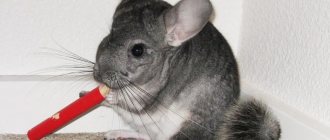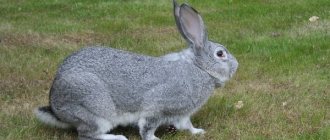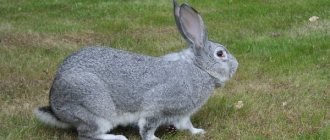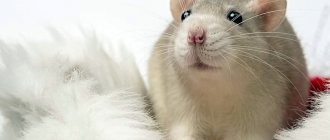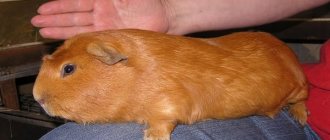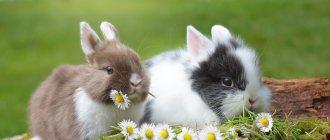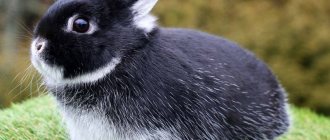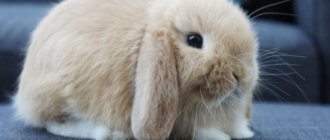№2
Their bodies are covered with unique fur. It is 30 times softer than human hair. Moreover, from one follicle (hair follicle), up to 50-80 strands can grow. Thanks to this, their fur is so dense that fleas or other parasites simply cannot settle in it. Naturally, such density also has its drawbacks. In order to cleanse its fur of the oil secreted by the body, the animal needs to regularly take dust baths.
Body structure and fur
Initially, Chinchis were exclusively gray, but today geneticists have bred white, beige, purple, sapphire (in fact, they have a light blue tint of fur). Animals of several black color varieties are also presented in nurseries. Unlike most cats and dogs, this fur-bearing animal does not shed, but can shed its fur in case of any danger or stress.
The structure of chinchilla fur is also interesting - it is distinguished by a very thick undercoat, which does not allow parasites (fleas or ticks) to settle on the animal. And in general, the fur is so thick that it has made its owner the world record holder for fur density. This property of chinchillas is understandable - fur helped their ancestors survive in the cold climate of their native habitat.
The mountain homeland gave the animals several more features:
bare and rather thick paw pads for confident movement on rocks and sharp stones;
the ability of red blood cells to carry more oxygen than the body of any other rodent can do, to breathe at high altitudes where only thin air is present;
the ability to sleep upside down, like a bat, and also in an upright position, because in its homeland the chinchilla had to spend the night in tiny crevices.
The front legs of chinchillas differ from the hind legs: they grow much faster and have 5 toes, while the hind legs have 4. The animal has a special skeletal structure - the bones allow the chinchilla to shrink vertically, which makes it possible to crawl into even the narrowest gap. In addition, the animals can jump to very high heights - up to two meters!
№3
In addition to its decorative function, their fur has a protective function. First of all, it protects the animal from the low temperatures characteristic of the mountainous regions where they live in the wild.
Also, their fur comes off very easily from the body. This helps the animal “jump out” from the mouth of a predator if it grabs it, simply by shedding a tuft of fur.
Origin of the species and description
Photo: Chinchilla
It is still unknown who the ancestor of the chinchilla is. Carrying out archaeological excavations in the Cordillera, scientists extracted from the bowels of the earth prehistoric fossils, which in their structure are very similar to chinchillas, only much larger in size. This animal, according to experts, lived forty thousand years ago, so the chinchilla genus is quite ancient. The Incas, many centuries ago, depicted chinchillas on rocks; this painting has survived to this day.
The Incas made various items of clothing from the soft skins of chinchillas, but among the Indians they were far from the first who were so attracted to the fur of rodents. The first who began to wear clothes made from chinchilla skins were the Indians from the Chyncha tribe. It is believed that the chinchilla got its name from them, because the word “chinchilla” itself is consonant with the name of an Indian tribe.
Video: Chinchilla
For the Incas, the value of chinchilla fur was very high; they maintained constant control over their production so as not to harm the animal population. But by the end of the 15th century the situation got out of control, because... The Spaniards who arrived on the mainland began a ruthless hunt for helpless rodents, which led to a rapid decrease in their numbers. The authorities of such South American countries as Chile, Bolivia and Argentina have banned the shooting of animals and their export, and introduced severe punishment for illegal hunting.
The chinchilla is a rodent from the chinchilla family of the same name.
These animals have two varieties:
- short-tailed chinchillas (coastal);
- Chinchillas are large, long-tailed (mountain).
Mountain chinchillas live at high altitudes (more than 2 km), their fur is thicker. This species is distinguished by a hump nose, which is designed for inhaling chilly mountain air. The coastal type of chinchillas is much smaller, but the tail and ears are much longer than those of mountain chinchillas. Officially, the short-tailed chinchilla species is believed to have disappeared completely, although local residents say they have been seen in remote mountainous areas of Argentina and Chile.
It is interesting that the first chinchilla farm was organized by the American Mathias Chapman, who brought the animals to the USA. He began to successfully breed chinchillas in order to sell their valuable fur; many then followed in his footsteps, organizing their own farms.
№6
One of the main evolutionary features of the chinchilla is its thick blood. It is thicker than that of humans and most other animals. This is due to the fact that there are more red blood cells in their blood. The more red blood cells there are, the more oxygen they can transport, which allows chinchillas to survive at high altitudes.
Character
By nature, chinchillas are very affectionate and tame; they almost never bite. The animal can bite only in a state of severe fright. All chinchillas are different, some like to be petted and others not so much, and these character traits need to be respected. What chinchillas do not tolerate is violence. In order to achieve mutual understanding with the animal, you need to show patience and persistence, and respect the peculiarities of its character and behavior.
After purchasing a chinchilla, you need to leave it alone for about a week and let it get used to its new place. Then, unpersistently, you need to extend your hand to her with a treat. If the chinchilla wants, she will come up, take the treat and climb into your arms. If not, you need to continue taming it day after day until the animal gets used to you.
A chinchilla may become offended if you leave it alone for a long time or simply do not pay attention to it. She won't want to play with you and won't even take treats from your hands.
Chinchillas are very good at manipulating their owners. They know exactly what needs to be done to get what they want: they will sit in a corner and look at you with sad eyes, or they will jump on their hind legs to get a treat or go for a walk around the room.
№7
Currently, there are only two types of them. These species include: Chinchilla lanigera and short-tailed chinchilla (Chinchilla brevicaudata). The first species, although rare, is found in the wild in the highlands of the Andes in Chile. The second species is currently considered almost extinct.
Laniger's chinchilla is the most common pet, while the short-tailed chinchilla is very rare. The Shorttail is distinguished from the Laniger by its shorter tail, smaller ears, wider shoulders and thicker neck.
History of domestication
It is known that the Indians were the first to domesticate these rodents. They gave them the name Chincha, which came from the name of a Peruvian tribe. Hunting for these animals was limited for the indigenous population.
They were brought to Europe by Mathias F. Chapman. At first he bought one individual, but this later encouraged him to be active. Thus, in 1919 he organized an expedition that consisted of 23 participants. The goal was to capture several individuals in the highlands of the Andean region in order to later transport them to the United States. The following facts are worth noting:
- One member of the expedition claimed that the journey to the base with the captured animal took them more than 4 weeks.
- Over three years, the group managed to catch only 12 individuals.
- In order to save the animals on a difficult journey in an unfavorable climate, members of the expedition used ice and covered the cages with a wet cloth.
- During the journey, one individual died, but the other gave birth to offspring.
- Most of the expedition founder's pets survived him. One animal even lived for 22 years.
№12
As we noted earlier, these are mountain rodents. In the mountains, sleeping conditions are not always the most comfortable. Therefore, chinchillas can be found sleeping in amazing positions. They may fall asleep lying upside down in a crevice, lying on their back, or literally standing on their head. The same can be observed in a cell. The animal retains its instinct, which is why it can sleep in amazing positions even in a comfortable corner in its cage.
Interesting facts about chinchillas
- Chinchillas are very active at sunset and sunrise. They also love twilight. Activity occurs at night. If a cage with animals is in your bedroom, then at first you may even be scared by the fact that couples are talking to each other, screaming, quarreling, grumbling. They have a fairly wide sound repertoire.
- The skin of chinchillas can be beige, gray, white, black. Or it may have a purple or sapphire color. one hair can be of different colors. Such color features make the fur of the animal visually attractive.
- Chinchillas' teeth grow all the time. That's why they chew all the time - they wear down their growing teeth. Many rodents have this feature.
- Chinchilla fur is considered very delicate and the softest.
- Chinchillas have adorable beady eyes. The color may be reddish or deep ruby.
№13
Most rodents, such as mice, hamsters, etc., live no more than a few years. Even if you compare chinchillas with other mammals such as rabbits, they live much longer.
While the average lifespan of rabbits ranges from 9 to 10 years, chinchillas can live up to 20 years. Naturally, at home. In the wild, due to the presence of various factors (predators, climatic conditions, etc.), their life expectancy is significantly reduced.
We also recommend reading: Interesting facts about parrots
Animal skeleton
The body structure of chinchillas provides them with reliable shelter and makes it possible to survive in rocky mountain conditions. The chinchilla's skeleton tapers when necessary. The need may arise when an animal hides in narrow crevices from predators and bad weather. There are 5 toes on the front legs of rodents, and 4 on the hind legs. The hind legs are longer and stronger than the front ones, which allows the animals to jump high.
Rodents have a set of 20 strong teeth that grow throughout their lives. Newborn babies have developed dental systems: there are 12 teeth at once.
How to determine the age of a chinchilla?
By external signs it is easy to determine the age of the animal. Determination is possible in several ways:
- By weight: at two months of age - up to 300 grams, at six months - up to 500 grams, per year - up to 800 grams.
- On the heels: young individuals have delicate skin on the heels. To determine age more accurately, the paws of an individual whose age is unknown can be compared with those for whom this indicator is known.
- According to the muzzle: with age, the muzzle becomes longer.
- In size: at 3-4 months a chinchilla is close to the size of a guinea pig, at 6 months and after the animal can be compared to a rabbit.
- By the color of the teeth: up to 2 months, the teeth are white, and when chinchillas grow up, the color of their teeth becomes orange.
- By sexual characteristics: in males, testicles appear by the fifth month of life; by the age of seven months, the genital organs are already easy to distinguish from female ones.
- According to the ear flaps: chinchillas with the beige gene begin to have flaps on their ears by the age of 5 months. There should be more than 2 of them per year, and in an adult at the age of 3-4 years, all the ears are covered with spots.
Difference between domestic and wild chinchillas
Domestic chinchillas raised in captivity are accustomed to people, and therefore have a very docile and calm character. They easily make contact and quickly get used to their owner.
Wild representatives of animals living in their natural habitat perceive humans as a danger. This is due to the fact that in those places where chinchillas are most often found, there are virtually no people. They are not used to their presence, so they are afraid and try to avoid them.
Due to their small size and flexible skeleton, they are quite fast and agile, and can crawl into virtually any crevice in an attempt to hide.
Chinchillas lead a colonial lifestyle, which means they prefer to stay close to each other. By forming a small flock, it is much easier for them to protect themselves from predators.
Chinchilla nutritional features
Like other herbivorous rodents (for example, the spiny mouse), chinchillas feed on various plants, mainly cereals, as well as seeds, moss, lichens, shrubs, tree bark, and occasionally small insects. In captivity, chinchillas eat exclusively dried foods (for example, dried apples, carrots, hay, nettles and dandelion roots); special granules are used as the main food.

